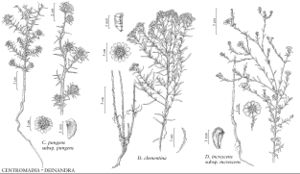Centromadia
Fl. Francisc. 4: 424. 1897.
| Taxon | Illustrator ⠉ | |
|---|---|---|
 | Centromadia pungens Deinandra clementina Deinandra increscens subsp. increscens | Marjorie C. Leggitt Marjorie C. Leggitt Marjorie C. Leggitt |
Annuals, 10–120 cm. Stems ± erect to prostrate. Leaves mostly cauline (at flowering); proximal opposite (often in winter–spring rosettes), most alternate; ± sessile; blades oblanceolate to linear or lance-linear, proximal usually 1–2-pinnatifid, ultimate margins toothed or entire (sometimes bristly-ciliate), (apices of distal leaves usually spine-tipped) faces glabrous, scabroso-hirtellous, ± hirsute, or villous, often glandular as well. Heads radiate, borne in glomerules or ± spiciform-paniculiform or ± umbelliform arrays. Peduncular bracts: pit-glands and tack-glands 0 (apices usually spine-tipped, sometimes apiculate). Involucres ± obconic or urceolate, 3–8+ mm diam. (subtended by calyculi of 5–12+ usually spine-tipped bractlets). Phyllaries falling or persistent, 5–75+ in 1 series (lanceolate to lance-attenuate or oblanceolate, herbaceous, each usually 1/2 enveloping subtended ray-floret proximally, abaxially scabroso-hirtellous, hirsute, or villous and/or glandular, apices often spine-tipped). Receptacles flat to convex, setulose, paleate (paleae persistent, subtending all or most disc-florets, distinct, phyllary-like, more scarious). Ray-florets 5–75+, pistillate, fertile; corollas yellow. Disc-florets 6–200+, usually functionally staminate, rarely bisexual and fertile; corollas yellow, tubes shorter than funnelform throats, lobes 5, deltate (anthers reddish to dark purple or yellow to brownish; styles glabrous proximal to branches). Ray cypselae ± compressed (abaxially gibbous, basal attachments basal or oblique, apices beaked or elevated adaxially, faces glabrous); pappi 0. Disc cypselae usually 0; pappi (of disc-florets) 0 or of 3–12 linear, oblanceolate, or subulate scales. x = 13.
Distribution
w United States, nw Mexico
Discussion
Species 4 (3 in the flora).
Following B. G. Baldwin (1999b), Centromadia is treated here as distinct from Hemizonia; Centromadia is more closely related to Calycadenia, Deinandra, Holocarpha, and Osmadenia than to Hemizonia in the strict sense (S. Carlquist et al. 2003). Taxa of Centromadia are self-incompatible and of low to high interfertility (C. S. Venkatesh 1958). Most occur in somewhat poorly drained or alkaline sites.
Selected References
Lower Taxa
Key
| 1 | Leaves not glandular; disc pappi 0 | Centromadia pungens |
| 1 | Leaves sometimes glandular; disc pappi of 3–5 linear to subulate scales, or 8–12 narrowly oblanceolate to linear scales | > 2 |
| 2 | Leaves densely villous or hirsute, stipitate-glandular (glands yellow, brown, or black); anthers reddish to dark purple; disc pappi of 8–12 linear or narrowly oblanceolatescales | Centromadia fitchii |
| 2 | Leaves glabrous, scabroso-hirtellous, ± hirsute to hirtellous, or villous, sometimes glandular (glands yellow); anthers yellow, brownish, or reddish to dark purple; discpappi of 3–5 linear to subulate scales | Centromadia parryi |